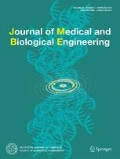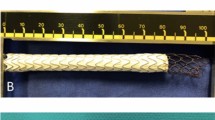Abstract
Purpose
Understanding the mechanical properties of current pessaries is important to improve on existing designs and innovate on novel solutions. Our objective was to mechanically characterize the force required to compress ring pessaries into a folded shape. We hypothesized that the force required to fold ring pessaries would scale inversely with the diameter squared.
Methods
We conducted a compression test on ring pessaries to analyze their folding behavior using a mechanical universal testing system. Ring pessaries size #1 through #7 (diameters 50.1–86.7 mm) were placed in the testing platform in a vertical orientation with the bending axis in the horizontal plane. An axial load was applied to induce deformation.
Results
With application of an axial force, all pessaries first showed in-plane deformation followed by out-of-plane buckling. Increasing force resulted in a transition between in-plane deformation and out-of-plane buckling, during which the pessary began to fold, analogous to classic Euler buckling of columns. This transition was reflected in the loading curve as a sharp change in slope between the initial strain-softening region and a subsequent nearly horizontal plateau region. The force at the transition point ranged from 4.4 N for a size #7 pessary to 23.5 N for a size #1 pessary. The relationship between force and diameter at the transition point appeared to approximate a 1/L2 dependence, where L is the pessary diameter.
Conclusions
Pessary mechanics show buckling and folding behavior with a dependence on pessary architecture. The force required to fold ring pessaries scales inversely with the pessary diameter squared.




Similar content being viewed by others
Availability of Data and Material
All data will be made available per request.
References
Cundiff, G. W., Amundsen, C. L., Bent, A. E., Coates, K. W., Schaffer, J. I., Strohbehn, K., & Handa, V. L. (2007). The PESSRI study: Symptom relief outcomes of a randomized crossover trial of the ring and Gellhorn pessaries. American Journal of Obstetrics and Gynecology. https://doi.org/10.1016/j.ajog.2007.02.018
Clemons, J. L., Aguilar, V. C., Tillinghast, T. A., Jackson, N. D., & Myers, D. L. (2004). Patient satisfaction and changes in prolapse and urinary symptoms in women who were fitted successfully with a pessary for pelvic organ prolapse. American Journal of Obstetrics and Gynecology, 190(4), 1025–1029. https://doi.org/10.1016/j.ajog.2003.10.711
Cundiff, G. W., Weidner, A. C., Visco, A. G., Bump, R. C., & Addison, W. A. (2000). A survey of pessary use by members of the American urogynecologic society. Obstetrics & Gynecology, 95(6 Pt 1), 931–935. https://doi.org/10.1016/S0029-7844(00)00788-2
Trowbridge, E. R., & Fenner, D. E. (2007). Practicalities and pitfalls of pessaries in older women. Clinical Obstetrics and Gynecology. https://doi.org/10.1097/GRF.0b013e3180d0a4ce
Jones, K. A., & Harmanli, O. (2010). Pessary use in pelvic organ prolapse and urinary incontinence. Reviews in Obstetrics and Gynecology, 3(1), 3–9. https://doi.org/10.3909/riog0110
Weber, A. M., & Richter, H. E. (2005). Pelvic organ prolapse. Obstetrics & Gynecology, 106(3), 615–634. https://doi.org/10.1097/01.AOG.0000175832.13266.bb
Robert, M., Ab, C., Schulz, J. A., Ab, E., Harvey, M.-A., & On, K. (2013). Technical update on pessary use. Journal of Obstetrics and Gynaecology Canada, 35(2947), 664–674.
Cheung, R. Y. K., Lee, L. L. L., Chung, T. K. H., & Chan, S. S. C. (2018). Predictors for dislodgment of vaginal pessary within one year in women with pelvic organ prolapse. Maturitas. https://doi.org/10.1016/j.maturitas.2017.11.008
Clemons, J. L., Aguilar, V. C., Tillinghast, T. A., Jackson, N. D., & Myers, D. L. (2004). Risk factors associated with an unsuccessful pessary fitting trial in women with pelvic organ prolapse. American Journal of Obstetrics and Gynecology. https://doi.org/10.1016/j.ajog.2003.08.034
Atnip, S. D. (2009). Pessary use and management for pelvic organ prolapse. Obstetrics and Gynecology Clinics of North America. https://doi.org/10.1016/j.ogc.2009.08.010
Thakar, R., & Stanton, S. (2002). Management of genital prolapse. BMJ, 324(7348), 1258–1262. https://doi.org/10.1136/bmj.324.7348.1258.
Holubyeva, A., Rimpel, K., Blakey-Cheung, S., Finamore, P. S., & O’Shaughnessy, D. L. (2021). Rates of pessary self-care and the characteristics of patients who perform it. Female pelvic medicine & reconstructive surgery, 27(3), 214–216. https://doi.org/10.1097/SPV.0000000000001013
Sasso, K., Hanson, L., & Smith, D. A. (2003). Case study: Challenges of pessary management. Journal of Wound, Ostomy and Continence Nursing, 30(3), 152–158. https://doi.org/10.1067/mjw.2003.123
Bugge, C., Dembinsky, M., Kearney, R., & Hagen, S. (2021). Does self-management of vaginal pessaries improve care for women with pelvic organ prolapse? The BMJ, 372, 1–4. https://doi.org/10.1136/bmj.n310
Barsky, M., Kelley, R., Bhora, F. Y., & Hardart, A. (2018). Customized pessary fabrication using three-dimensional printing technology. Obstetrics and Gynecology, 131(3), 493–497. https://doi.org/10.1097/AOG.0000000000002461
Deng, B., Raney, J. R., Tournat, V., & Bertoldi, K. (2017). Elastic vector solitons in soft architected materials. Physical Review Letters, 118(20), 204102. https://doi.org/10.1103/PhysRevLett.118.204102
Chem, B., Jiang, Y., Liu, C., Raney, J. R., & Reina, C. (2021). Dynamic behavior of soft, resonant metamaterials: Experiments and simulations. Journal of Applied Physics, 129(13), 135104. https://doi.org/10.1063/5.0042456
Timoshenko, S. P., Gere, J. M. (1961). Theory of elastic stability (2nd edn.). McGraw-Hill.
Gibson, L. J., & Ashby, M. F. (1997). Cellular solids. Cambridge University Press. https://doi.org/10.1017/CBO9781139878326
Cacciari, L. P., Pássaro, A. C., Amorim, A. C., Geuder, M., & Sacco, I. C. N. (2017). Novel instrumented probe for measuring 3D pressure distribution along the vaginal canal. Journal of Biomechanics. https://doi.org/10.1016/j.jbiomech.2017.04.035
Guttormson, R., Tschirhart, J., Boysen, D., & Martinson, K. (2008). The Midwest Surgical Association are postoperative activity restrictions evidence-based? The American Journal of Surgery. https://doi.org/10.1016/j.amjsurg.2007.12.014
Pereira-Correia, J. A., Rosa, L. P. L., da Silva Costa, V. R., Berle, F. V. D., Werneck, B. M., dos Santos, K. P. R., de Sousa Araujo, G. B., de Carvalho Bittencourt Sodre, M. J., de Fassio, R. L. R., & Muller, V. J. F. (2018). Comparison of vesical pressure values achieved by Valsalva maneuvers: A standardization proposal. Neurourology and Urodynamics, 37(7), 2191–2194. https://doi.org/10.1002/nau.23558.
Funding
This project was partially funded by Penn Health-Tech at University of Pennsylvania.
Author information
Authors and Affiliations
Contributions
CXH: project development, data analysis, manuscript writing/editing. MC: data collection, data analysis, manuscript writing/editing. HY: data analysis, manuscript writing/editing. EM: manuscript writing/editing. LAA: project development, manuscript writing/editing. JRR: project development, data analysis, manuscript writing/editing.
Corresponding author
Ethics declarations
Conflict of interest
Christopher X. Hong is a consultant/advisor for Cosm Medical Corp., Toronto, ON, Canada. All other authors disclose no conflicts of interest.
Ethical Approval
This study did not meet the criteria for human subject research and was thus exempt from Institutional Review Board review.
Rights and permissions
About this article
Cite this article
Hong, C.X., Cioban, M., Yasuda, H. et al. Mechanical Characterization of Ring Pessary Folding. J. Med. Biol. Eng. 41, 343–349 (2021). https://doi.org/10.1007/s40846-021-00618-y
Received:
Accepted:
Published:
Issue Date:
DOI: https://doi.org/10.1007/s40846-021-00618-y




